Who Is Art Metal Lockers Sales Rep in Cleveland
Short visual history of article of furniture styles (from left to right): cloisonné plaque (Assyrian), Chair of Reniseneb (Ancient Egyptian), metal brazier with satyrs from Pompei (Greco-Roman), autumn-forepart cabinet inlaid with ivory (Indian), low-back armchair (Chinese), catafalque with images of Cupids (Byzantine), wood and ivory furniture fragment (Islamic), breast (Gothic), analogion (Romanian Medieval), sideboard with two bodies (Renaissance), gold table (Bizarre), commode (Rococo), armchair with cornucopia (Louis 16), secretary (Empire), fauteuil a joues armchair (19th century Eclecticism and/or Revivalism), vitrine (Art Nouveau), commode (Fine art Deco), IKEA kitchen cupboards and a table with glass top (Contemporary)
Article of furniture refers to movable objects intended to support various human activities such as seating (e.chiliad., stools, chairs, and sofas), eating (tables), storing items, eating and/or working with an particular, and sleeping (east.g., beds and hammocks). Furniture is also used to agree objects at a convenient elevation for piece of work (as horizontal surfaces above the ground, such every bit tables and desks), or to store things (east.1000., cupboards, shelves, and drawers). Furniture tin be a product of blueprint and can exist considered a form of decorative art. In addition to furniture'due south functional role, it can serve a symbolic or religious purpose. Information technology tin can be made from a vast multitude of materials, including metallic, plastic, and forest. Furniture tin be made using a variety of woodworking joints which ofttimes reflects the local culture.
People have been using natural objects, such as tree stumps, rocks and moss, as furniture since the start of human civilisation and continues today in some households/campsites. Archaeological inquiry shows that from around xxx,000 years agone, people started to construct and carve their own piece of furniture, using wood, stone, and animal basic. Early furniture from this menstruation is known from artwork such as a Venus figurine establish in Russian federation, depicting the goddess on a throne. The first surviving extant furniture is in the homes of Skara Brae in Scotland, and includes cupboards, dressers and beds all constructed from stone. Complex construction techniques such equally joinery began in the early dynastic menstruation of ancient Arab republic of egypt. This era saw synthetic wooden pieces, including stools and tables, sometimes decorated with valuable metals or ivory. The evolution of article of furniture design continued in ancient Hellenic republic and ancient Rome, with thrones being commonplace likewise as the klinai, multipurpose couches used for relaxing, eating, and sleeping. The piece of furniture of the Middle Ages was usually heavy, oak, and ornamented. Article of furniture design expanded during the Italian Renaissance of the fourteenth and fifteenth century. The seventeenth century, in both Southern and Northern Europe, was characterized by opulent, ofttimes gilded Baroque designs. The nineteenth century is usually divers past revival styles. The first three-quarters of the twentieth century are often seen as the march towards Modernism. One unique outgrowth of post-modern furniture pattern is a return to natural shapes and textures.[1]
Etymology [edit]
The English language word furniture is derived from the French discussion fourniture ,[2] the substantive form of fournir , which means to supply or provide.[iii] Thus fourniture in French means supplies or provisions.[4] The English usage, referring specifically to household objects, is specific to that language;[5] French and other Romance languages as well as German use variants of the word meubles, which derives from Latin mobilia, significant "moveable appurtenances".[half dozen]
History [edit]
Prehistory [edit]
The practice of using natural objects as rudimentary pieces of furniture probable dates to the first of homo civilization.[vii] Early humans are likely to take used tree stumps as seats, rocks as rudimentary tables, and mossy areas for sleeping.[7] During the tardily Paleolithic or early Neolithic period, from around 30,000 years agone, people began constructing and carving their own furniture, using wood, stone and animal bones.[8] The primeval prove for the existence of constructed furniture is a Venus figurine found at the Gagarino site in Russia, which depicts the goddess in a sitting position, on a throne.[ix] A similar statue of a seated woman was found in Catal Huyuk in Turkey, dating to between 6000 and 5500 BCE.[7] The inclusion of such a seat in the figurines implies that these were already common artefacts of that historic period.[9]
A range of unique rock article of furniture has been excavated in Skara Brae, a Neolithic village in Orkney, Scotland The site dates from 3100 to 2500 BCE and due to a shortage of wood in Orkney, the people of Skara Brae were forced to build with stone, a readily available fabric that could exist worked easily and turned into items for use within the household. Each firm shows a high degree of sophistication and was equipped with an extensive array of rock furniture, ranging from cupboards, dressers, and beds to shelves, stone seats, and limpet tanks. The stone dresser was regarded as the most of import every bit it symbolically faces the entrance in each house and is therefore the first item seen when entering, perchance displaying symbolic objects, including decorative artwork such every bit several Neolithic carved stone assurance too found at the site.
-

A dresser with shelves furnish a house in Skara Brae, a settlement in what is now Scotland that was occupied from about 3180-2500 BC
-
Cucuteni figurine staying on a miniature chair; 4750-4700 BC; ceramic; discoeved at Târpești (modern-day Romania); Archaeology Museum Piatra Neamț
Artifact [edit]
Ancient piece of furniture has been excavated from the eighth-century BCE Phrygian tumulus, the Midas Mound, in Gordion, Turkey. Pieces found hither include tables and inlaid serving stands. There are also surviving works from the ninth-8th-century BCE Assyrian palace of Nimrud. The earliest surviving rug, the Pazyryk Carpet was discovered in a frozen tomb in Siberia and has been dated between the 6th and 3rd century BCE.
Aboriginal Arab republic of egypt [edit]
Civilization in ancient Egypt began with the clearance and irrigation of land forth the banks of the River Nile,[ten] which began in about 6000 BCE. By that time, society in the Nile Valley was already engaged in organized agronomics and the construction of large buildings.[11] At this period, Egyptians in the southwestern corner of Arab republic of egypt were herding cattle and also amalgam large buildings. Mortar was in use by around 4000 BCE The inhabitants of the Nile Valley and delta were cocky-sufficient and were raising barley and emmer (an early diverseness of wheat) and stored it in pits lined with reed mats.[12] They raised cattle, goats and pigs and they wove linens and baskets.[12] Show of furniture from the predynastic menstruum is scarce, merely samples from Kickoff Dynasty tombs indicate an already advanced apply of furnishings in the houses of the age.[13]
During the dynastic period, which began in around 3200 BCE, Egyptian art developed significantly, and this included furniture design.[14] Egyptian furniture was primarily constructed using wood, but other materials were sometimes used, such equally leather,[15] and pieces were often adorned with gold, argent, ivory and ebony, for decoration.[fifteen] Wood establish in Egypt was not suitable for furniture construction, so information technology had to be imported into the country from other places,[14] especially Phoenicia.[16] The scarcity of woods necessitated innovation in construction techniques. The use of scarf joints to join two shorter pieces together and form a longer beam was one instance of this,[17] too as structure of veneers in which low quality inexpensive wood was used as the principal building textile, with a thin layer of expensive forest on the surface.[18]
The earliest used seating furniture in the dynastic period was the stool, which was used throughout Egyptian society, from the royal family down to ordinary citizens.[19] Diverse different designs were used, including stools with iv vertical legs, and others with crossed splayed legs; near all had rectangular seats, however.[19] Examples include the workman'south stool, a simple three legged construction with a concave seat, designed for condolement during labour,[20] and the much more ornate folding stool, with crossed folding legs,[21] which were busy with carved duck heads and ivory,[21] and had hinges fabricated of statuary.[nineteen] Full chairs were much rarer in early Arab republic of egypt, being express to only wealthy and high ranking people, and seen as a status symbol; they did not achieve ordinary households until the 18th dynasty.[22] Early examples were formed by calculation a directly back to a stool, while afterward chairs had an inclined dorsum.[22] Other article of furniture types in ancient Arab republic of egypt include tables, which are heavily represented in art, but almost nonexistent as preserved items – maybe because they were placed outside tombs rather than within,[23] besides as beds and storage chests.[24] [25]
-

Stool with woven seat; 1991–1450 BC; forest & reed; pinnacle: 13 cm; Metropolitan Museum of Art
-

Jewelry chest of Sithathoryunet; 1887–1813 BC; ebony, ivory, gold, carnelian, blue faience and argent; height: 36.7 cm; Metropolitan Museum of Art
-

Chair of Hatnefer; 1492–1473 BC; boxwood, cypress, ebony & linen cord; height: 53 cm; Metropolitan Museum of Art
Aboriginal Hellenic republic [edit]

3 illustrations of ancient Greek chairs, each beingness notated with a letter: a, b-klismos, and c-chair
Historical knowledge of Greek furniture is derived from various sources, including literature, terra cotta, sculptures, statuettes, and painted vases.[26] Some pieces survive to this day, primarily those constructed from metals, including bronze, or marble.[26] Forest was an important and mutual fabric in Greek furniture, both domestic and imported.[26] A common technique was to construct the main sections of the furniture with cheap solid wood, then apply a veneer using an expensive wood, such equally maple or ebony.[26] Greek article of furniture structure also made use of dowels and tenons for joining the wooden parts of a slice together.[26] Wood was shaped by etching, steam treatment, and the lathe, and furniture is known to have been decorated with ivory, tortoise shell, glass, golden or other precious materials.[27]
The mod word "throne" is derived from the ancient Greek thronos (Greek singular: θρόνος), which was a seat designated for deities or individuals of high status/hierarchy or honor.[28] The colossal chryselephantine statue of Zeus at Olympia, synthetic by Phidias and lost in antiquity, featured the god Zeus seated on an elaborate throne, which was busy with gold, precious stones, ebony and ivory, co-ordinate to Pausanias.[29] Other Greek seats included the klismos, an elegant Greek chair with a curved backrest and legs whose form was copied by the Romans and is now part of the vocabulary of article of furniture pattern,[30] the backless stool (diphros), which existed in about Greek homes,[31] and folding stool.[32] The kline, used from the late seventh century BCE,[33] was a multipurpose piece used equally a bed, simply also as a sofa and for reclining during meals.[34] It was rectangular and supported on four legs, ii of which could be longer than the other, providing support for an armrest or headboard.[35] Mattresses, rugs, and blankets may have been used, but there is no evidence for sheets.[34]
In full general, Greek tables were low and often announced in depictions aslope klinai.[36] The most mutual type of Greek table had a rectangular top supported on three legs, although numerous configurations exist, including trapezoid and round.[37] Tables in ancient Greece were used mostly for dining purposes – in depictions of banquets, it appears every bit though each participant would have utilized a single table, rather than a collective use of a larger slice.[38] Tables also figured prominently in religious contexts, as indicated in vase paintings, for example, the wine vessel associated with Dionysus, dating to around 450 BCE and at present housed at the Fine art Institute of Chicago.[39] Chests were used for storage of dress and personal items and were usually rectangular with hinged lids.[37] Chests depicted in terracotta bear witness elaborate patterns and design, including the Greek fret.[34]
-
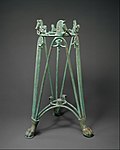
Rod tripod stand; early on 6th century BC; bronze; overall: 75.2 x 44.5 cm; Metropolitan Museum of Fine art
Aboriginal Rome [edit]
Roman article of furniture was based heavily on Greek article of furniture, in style and construction. Rome gradually superseded Hellenic republic as the foremost culture of Europe, leading eventually to Greece becoming a province of Rome in 146 BC. Rome thus took over production and distribution of Greek furniture, and the boundary betwixt the 2 is blurred. The Romans did have some express innovation outside of Greek influence, and styles distinctly their own.[40]
Roman furniture was synthetic principally using forest, metal and stone, with marble and limestone used for outside furniture. Very lilliputian wooden article of furniture survives intact, but at that place is prove that a variety of woods were used, including maple, citron, beech, oak, and holly. Some imported wood such as satinwood was used for decoration. The most commonly used metal was bronze, of which numerous examples have survived, for instance, headrests for couches and metal stools. Similar to the Greeks, Romans used tenons, dowels, nails, and glue to bring together wooden pieces together, and also practised veneering.[40]
The 1738 and 1748 excavations of Herculaneum and Pompeii revealed Roman furniture, preserved in the ashes of the Advertizing 79 eruption of Vesuvius.
-

Illustration of Roman furniture details, from 1900, very similar with Empire style piece of furniture
-

Couch and footstool with bone carvings and drinking glass inlays; 1st–2d century Advertising; wood, bone and glass; burrow: 105.iv × 76.2 × 214.6 cm; Metropolitan Museum of Art (New York Metropolis)
Middle Ages [edit]

In contrast to the ancient civilizations of Egypt, Greece, and Rome, there is comparatively little bear witness of article of furniture from the fifth to the 15th century.[41] Very few extant pieces survive, and evidence in literature is as well scarce.[41] It is likely that the manner of piece of furniture prevalent in late artifact persisted throughout the middle ages.[41] For example, a throne similar to that of Zeus is depicted in a 6th-century diptych,[41] while the Bayeux tapestry shows Edward the Confessor and Harold seated on seats similar to the Roman sella curulis.[42] The furniture of the Middle Ages was usually heavy, oak, and ornamented with carved designs.
The Hellenistic influence upon Byzantine furniture can exist seen through the use of acanthus leaves, palmettes, bay and olive leaves as ornaments. Oriental influences manifest through rosettes, arabesques and the geometric stylisation of certain vegetal motifs. Christianity brings symbols in Byzantine ornamentation: the dove, fishes, the lamb and vines.[43] The piece of furniture from Byzantine houses and palaces was commonly luxurious, highly busy and finely ornamented. Stone, marble, metallic, wood and ivory are used. Surfaces and ornaments are gilded, painted plychrome, plated with sheets of gold, emailed in vivid colors, and covered in precious stones. The variety of Byzantine furniture is pretty big: tables with square, rectangle or round top, sumptuous decorated, fabricated of wood sometimes inlaid, with bronze, ivory or silver ornaments; chairs with high backs and with wool blankets or creature furs, with coloured pillows, so banks and stools; wardrobes were used only for storing books; cloths and valuable objects were kept in chests, with iron locks; the course of beds imitated the roman ones, but have dissimilar designs of legs.[44]
The main ornamentation of Gothic piece of furniture and all applied arts is the ogive. The geometric rosette accompanies the ogive many times, having a large variety of forms. Architectural elements are used at furniture, at the starting time with purely decorative reasons, but later as structure elements. Likewise the ogive, the chief ornaments are: acanthus leaves, ivy, oak leaves, haulms, clovers, fleurs-de-lis, knights with shields, heads with crowns and characters from the Bible. Chests are the main type of Gothic furniture used by the majority of the population. Ordinarily, the locks and escutcheon of chests have also an ornamental scope, being finely made.[45]
-
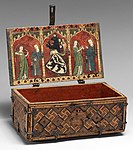
Gothic coffret (Minnekästchen); circa 1325–1350; oak, inlay, tempera, wrought-iron mounts; overall: 12.1 10 27.iii ten sixteen.5 cm; Metropolitan Museum of Fine art (New York City)
-

Gothic chest; late 15th century; wood; 30.2 x 29.2 10 39.4 cm; Metropolitan Museum of Art
-

Gothic chest; late 15th century; walnut and fe; overall: 47 ten 38.7 x 75.9 cm; Metropolitan Museum of Fine art
-

Renaissance [edit]
Along with the other arts, the Italian Renaissance of the fourteenth and fifteenth century marked a rebirth in design, oftentimes inspired by the Greco-Roman tradition. A like explosion of design, and renaissance of civilisation in full general occurred in Northern Europe, starting in the fifteenth century.
-

Wardrobe; c.1530; carved walnut; elevation: 230 cm; Château d'Écouen[49]
-

Closet; c.1570; wood; height: 246 cm; Château d'Écouen[50]
-

Cupboard; c. 1580; walnut and oak, partially gilded and painted; height: 2.06 yard, width: 1.50 thousand; Louvre[51]
17th and 18th centuries [edit]
The 17th century, in both Southern and Northern Europe, was characterized by opulent, often aureate Baroque designs that frequently incorporated a profusion of vegetal and scrolling ornament. Starting in the eighteenth century, furniture designs began to develop more rapidly. Although there were some styles that belonged primarily to ane nation, such as Palladianism in Dandy Uk or Louis Quinze in French article of furniture, others, such as the Rococo and Neoclassicism were perpetuated throughout Western Europe.
During the 18th century, the way was gear up in England by the French art. In the beginning of the century Boulle cabinets were at the height of their popularity and Louis XIV was reigning in France. In this era, virtually of the furniture had metal and enamelled decorations in information technology and some of the furniture was covered in inlays of marbles lapis lazuli, and porphyry and other stones. By mid-century this Bizarre style was displaced by the graceful curves, shining ormolu, and intricate marquetry of the Rococo mode, which in turn gave mode around 1770 to the more astringent lines of Neoclassicism, modeled afterward the compages of ancient Greece and Rome.[52] Creating a mass market for piece of furniture, the distinguished London cabinet maker Thomas Chippendale'south The Gentleman and Chiffonier Maker's Managing director (1754) is regarded as the "start comprehensive trade catalogue of its kind".[53]
There is something so singled-out in the evolution of gustation in French furniture, marked out past the three styles to which the three monarchs accept given the name of "Louis Quatorze", "Louis Quinze", and "Louis Seize". This will be evident to anyone who will visit, offset the Palace of Versailles, so the One thousand Trianon, and subsequently the Petit Trianon.[54]
-

Baroque four-poster bed from the Château d'Effiat; c.1650; natural walnut, chiselled Genoa silk velvet and embroidered silks; 295 cm; Louvre[55]
-

Baroque cupboard; past André Charles Boulle; c.1700; ebony and amaranth veneering, polychrome woods, brass, tin, shell, and horn marquetry on an oak frame, gilt-bronze; 255.5 x 157.v cm; Louvre[57]
-
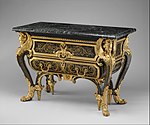
Baroque commode; by André Charles Boulle; c.1710-1732; walnut veneered with ebony and marquetry of engraved brass and tortoiseshell, gilt-bronze mounts, antique marble meridian; 87.6 x 128.3 ten 62.ix cm; Metropolitan Museum of Art (New York Metropolis)[58]
-

Baroque slant-front desk; by Heinrich Ludwig Rohde or Ferdinand Plitzner; c.1715–1725; marquetry with maple, amaranth, mahogany, and walnut on spruce and oak; 90 × 84 × 44.v cm; Art Found of Chicago[59]
-

Rococo panel table; 18th century; carved and gilded wood, marble tiptop; 63.2 × threescore × 25.iv cm; Metropolitan Museum of Art
-
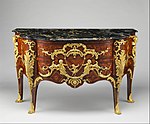
Rococo commode; past Charles Cressent; c.1745-1749; pino and oak veneered with amaranth and bois satiné, walnut, oak, pino; gilded-bronze, portoro marble top; 87.six x 139.7 x 57.8 cm; Metropolitan Museum of Art
-

Rococo side table (commode en panel); by Bernard 2 van Risamburgh; c.1755-1760; Japanese lacquer, gilt-bronze and Sarrancolin marble tiptop; height: 90.ii cm; Metropolitan Museum of Art
-

Louis XVI manner gyre-summit desk-bound of Marie-Antoinette; by Jean-Henri Riesener; 1784; oak and pine frame, sycamore, amaranth and rosewood veneer, bronze gilt; 103.vi x 113.4 cm; Louvre[63]
-
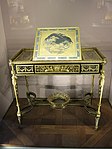
Louis XVI manner writing table of Marie-Antoinette; by Adam Weisweiler; 1784; oak, ebony and sycamore veneer, Japanese lacquer, steel, bronze gilt; 73.7 x 81. ii cm; Louvre[64]
-

Louis XVI style folding stool (pliant); 1786; carved and painted beechwood, covered in pink silk; 46.4 × 68.6 × 51.4 cm; Metropolitan Museum of Art
-
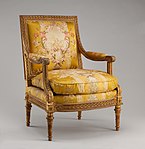
Louis 16 style armchair (fauteuil) from Louis XVI's Salon des Jeux at Saint Cloud; 1788; carved and gilt walnut, gold brocaded silk (non original); overall: 100 × 74.9 × 65.1 cm; Metropolitan Museum of Art
19th century [edit]
The nineteenth century is normally defined by concurrent revival styles, including Gothic, Neoclassicism, and Rococo. The design reforms of the late century introduced the Aesthetic movement and the Arts and crafts movement. Art Nouveau was influenced past both of these movements. Shaker-style furniture became popular during this time in North America too.
-
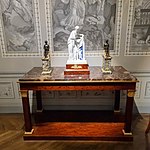
Empire console table; 1804-1814; mahogany, gold statuary, chiseled gilded bronze and fossil gray marble; 91.5 x 154 x 73.5 cm; Musée des Arts Décoratifs (Paris)[65]
Early Northward American [edit]
This design was in many means rooted in necessity and emphasizes both grade and materials. Early British Colonial American[ vague ] chairs and tables are often constructed with turned spindles and chair backs often synthetic with steaming to curve the forest. Wood choices tend to be deciduous hardwoods with a particular emphasis on the wood of edible or fruit bearing trees such equally ruddy or walnut.[ citation needed ]
Modernism [edit]

The starting time three-quarters of the twentieth century is often seen every bit the march towards Modernism. Art Deco, De Stijl, Bauhaus, Jugendstil, Wiener Werkstätte, and Vienna Secession designers all worked to some degree inside the Modernist idiom. Born from the Bauhaus and Art Deco/Streamline styles came the post WWII "Mid-Century Modern" way using materials developed during the war including laminated plywood, plastics, and fiberglass. Prime number examples include furniture designed by George Nelson Associates, Charles and Ray Eames, Paul McCobb, Florence Knoll, Harry Bertoia, Eero Saarinen, Harvey Probber, Vladamir Kagan and Danish modern designers including Finn Juhl and Arne Jacobsen. Postmodern pattern, intersecting the Popular art movement, gained steam in the 1960s and 70s, promoted in the 80s by groups such every bit the Italian republic-based Memphis move. Transitional article of furniture is intended to fill a place between Traditional and Modern tastes.

Stainless Steel Table with FSC Teca Wood - Brazil Ecodesign
Ecodesign [edit]
Dandy efforts from individuals, governments, and companies has led to the manufacturing of products with higher sustainability known equally Ecodesign. This new line of furniture is based on environmentally friendly design. Its use and popularity are increasing each yr.[70]
Contemporary [edit]
One unique outgrowth of post-modern furniture design is Live edge, heralding a return to natural shapes and textures inside the home.[one]
Asian history [edit]
Asian article of furniture has a quite distinct history. The traditions out of India, China, Korea, Pakistan, Indonesia (Bali and Coffee) and Japan are some of the all-time known, but places such equally Mongolia, and the countries of South East Asia have unique facets of their ain.
Far Eastern [edit]
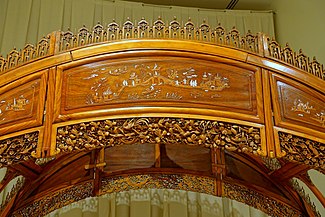
Detail of a Chinese moon-gate bed from circa 1876
The use of uncarved woods and bamboo and the utilise of heavy lacquers are well known Chinese styles. It is worth noting that Chinese furniture varies dramatically from one dynasty to the next. Chinese ornamentation is highly inspired by paintings, with floral and plant life motifs including bamboo trees, chrysanthemums, waterlilies, irises, magnolias, flowers and branches of cherry, apple, apricot and plum, or elongated bamboo leaves; animal ornaments include lions, bulls, ducks, peacocks, parrots, pheasants, roosters, ibises and butterflies. The dragon is the symbol of globe fertility, and of the ability and wisdom of the emperor. Lacquers are mostly populated with princesses, various Chinese people, soldiers, children, ritually and daily scenes. Architectural features tend toward geometric ornaments, like meanders and labyrinths. The interior of a Chinese firm was uncomplicated and sober. All Chinese furniture is made of wood, usually ebony, teak, or rosewood for heavier furniture (chairs, tables and benches) and bamboo, pino and larch for lighter furniture (stools and small chairs).[71]
Traditional Japanese furniture is well known for its minimalist style, extensive use of wood, high-quality craftsmanship and reliance on forest grain instead of painting or thick lacquer. Japanese chests are known equally Tansu, known for elaborate decorative iron work, and are some of the most sought-afterward of Japanese antiques. The antiques available generally date back to the Tokugawa and Meiji periods. Both the technique of lacquering and the specific lacquer (resin of Rhus vernicifera) originated in China, only the lacquer tree also grows well in Japan. The recipes of preparation are original to Japan: resin is mixed with wheat flour, clay or pottery powder, turpentine, iron powder or wood coal. In ornamentation, the chrysanthemum, known as kiku, the national flower, is a very popular ornamentation, including the 16-petal chrysanthemum symbolizing the Emperor. Ruby-red and apple flowers are used for decorating screens, vases and shōji. Common animate being ornaments include dragons, carps, cranes, gooses, tigers, horses and monkeys; representations of compages such every bit houses, pavilions, towers, torii gates, bridges and temples are also common. The furniture of a Japanese house consists of tables, shelves, wardrobes, small holders for flowers, bonsais or for bonkei, boxes, lanterns with wooden frames and translucent paper, neck and elbow holders, and jardinieres.[72]
-

Japanese chest with cartouche showing figures on donkeys in a landscape; 1750–1800; carved cerise lacquer on woods core with metal fittings and jade lock; 30.64 ten 30.16 x 12.vii cm; Los Angeles County Museum of Fine art (USA)
-

Japanese tiered nutrient Box with stand; belatedly 18th century; red lacquer over a forest core, with litharge painting and engraved gold designs; overall: 53 x 68 cm; Cleveland Museum of Art
-

Japanese writing table; early 20th century; lacquered wood with silver fittings and various other materials; top: 12.3 cm, length: 60.96 cm, width: 36.83 cm; Metropolitan Museum of Art (New York City)
Types [edit]
For sitting [edit]
Seating is among the oldest known furniture types, and authors including Encyclopædia Britannica regard information technology as the nigh important.[ii] In boosted to the functional design, seating has had an important decorative element from ancient times to the nowadays day. This includes carved and sculpted pieces intended as works of fine art, as well equally the styling of seats to indicate social importance, with senior figures or leaders granted the use of specially designed seats.[two]
The simplest form of seat is the chair,[73] which is a slice of furniture designed to allow a unmarried person to sit down, which has a dorsum and legs, also as a platform for sitting.[74] Chairs oft characteristic cushions made from diverse fabrics.[75]
-
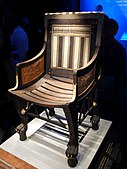
Ancient Egyptian armchair of Tutankhamun; 1336-1326 BC; wood, ebony, ivory and gilt leaf; height: 71 cm; Exposition of Tutankhamun Treasure in Paris (2019)
-

Louis 16 armchair (Fauteuil à la reine); 1780–1785; carved and gilded walnut, and embroidered silk satin; top: 102.2 cm, width: 74.9 cm, depth: 77.8 cm; Metropolitan Museum of Art
-

Louis XVI settee; designed in circa 1786, woven 1790–91, settee frame from the second half 19th century; carved and gilded wood, with wool and silk; 107.3 × 191.5 × 71.1 cm; Metropolitan Museum of Fine art
Types of wood used [edit]
All different types of woods have unique signature marks that can help in like shooting fish in a barrel identification of the type. Both hardwoods and softwoods are used in piece of furniture manufacturing, and each has its own specific uses.[76] Common softwoods used include pine, redwood and yew. Higher quality furniture tends to be made out of hardwood, including oak, maple, mahogany, teak, walnut, cherry and birch. Highest quality wood will take been air dried to rid it of its moisture.[77]
Standards for blueprint, functionality and prophylactic [edit]

Installment past L. Gargantini for the Bolzano fair, 1957. Photo by Paolo Monti (Fondo Paolo Monti, BEIC).
- EN 527 Part furniture – Work tables and desks
- EN 1335 Part article of furniture – Office piece of work chair
- ANSI/BIFMA X 5.1 Part Seating
- DIN 4551 Part furniture; revolving office chair with adjustable dorsum with or without arm rests, adjustable in height
- EN 581 Outdoor article of furniture – Seating and tables for camping ground, domestic and contract use
- EN 1728:2014 Furniture – Seating – Test methods for the determination of strength and durability– updated in 2014.[78]
- EN 1730:2012 Article of furniture – Test methods for the determination of stability, strength and immovability.
- BS 4875 Article of furniture. Strength and stability of article of furniture. Methods for determination of stability of non-domestic storage piece of furniture (British Standard)
- EN 747 Furniture – Bunk beds and high beds – Test methods for the determination of stability, strength and immovability
- EN 13150 Workbenches for laboratories – Safe requirements and test methods
- EN 1729 Educational furniture, chairs and tables for educational institutions[79]
- RAL-GZ 430 Piece of furniture standard from Germany
- NEN 1812 Article of furniture standard from the Netherlands
- GB 28007-2011 Children's furniture – Full general technical requirements for children'south furniture designed and manufactured for children between three and fourteen years onetime
- BS 5852: 2006 Methods of examination for cess of the ignitability of upholstered seating past smouldering and flaming ignition sources
- BS 7176: Specification for resistance to ignition of upholstered furniture for non-domestic seating past testing composites
See also [edit]
- Casters which brand some furniture moveable
- Furniture designer
- Furniture museum
- Metal furniture
- Multifunctional piece of furniture
Notes [edit]
- ^ a b Greyness, Channing. "Haute and cool: Fine Furnishings show branches out in 10th year with a bigger spread of archetype and cutting-edge pieces". The Providence Journal.
- ^ a b c "Furniture". Encyclopædia Britannica. 23 Feb 2016. Archived from the original on 16 May 2016. Retrieved 16 May 2016.
- ^ "English language Translation of "fournir"". Collins French-English Dictionary.
- ^ "English Translation of "fourniture"". Collins French-English Lexicon.
- ^ Weekley 2013, pp. 609–610.
- ^ Solodow 2010, p. 146.
- ^ a b c Smardzewski 2015, p. 4.
- ^ Smardzewski 2015, p. 1.
- ^ a b Smardzewski 2015, p. 2.
- ^ Roebuck 1966, p. 51.
- ^ Redford, Donald B. Egypt, Canaan, and State of israel in Ancient Times. (Princeton: Academy Press, 1992), p. six.
- ^ a b Roebuck 1966, p. 52.
- ^ Metropolitan Museum of Art 1999, p. 117.
- ^ a b Blakemore 2006, p. i.
- ^ a b Blakemore 2006, p. fourteen.
- ^ Gadalla 2007, p. 243.
- ^ Smardzewski 2015, pp. xiii–xiv.
- ^ Smardzewski 2015, p. xiv.
- ^ a b c Blakemore 2006, p. 15.
- ^ Litchfield 2011, p. 6.
- ^ a b Litchfield 2011, pp. vi–7.
- ^ a b Blakemore 2006, p. 17.
- ^ Blakemore 2006, p. 21.
- ^ Blakemore 2006, p. 22.
- ^ Blakemore 2006, p. 24.
- ^ a b c d eastward Blakemore 2006, p. 39.
- ^ Richter 1966, p. 125.
- ^ Richter 1966, p. 13.
- ^ Richter 1966, pp. 14, NH 5.11.2ff.
- ^ Linda Maria Gigante, "Funerary Art," in The Oxford Encyclopedia of Ancient Greece and Rome, Vol. 1, ed. Michael Gagarin and Elaine Fantham (Oxford: Oxford University Press, 2010), 246.
- ^ Guhl, E.; Koner, W. (1989). Everyday Life in Greek and Roman Times. New York: Crescent. p. 133.
- ^ Wanscher 1980, p. 83.
- ^ Simpson, 253.[ full citation needed ]
- ^ a b c Blakemore 2006, p. 43.
- ^ Andrianou, 36.[ full citation needed ]
- ^ Richter 1966, p. 63.
- ^ a b Blakemore 2006, p. 42.
- ^ Richter 1966, p. 66.
- ^ Chicago Painter. "Stamnos (Mixing Jar)". Art Constitute of Chicago.
- ^ a b Blakemore 2006, p. 61.
- ^ a b c d Lucie-Smith 1979, p. 33.
- ^ Lucie-Smith 1979, p. 35.
- ^ Bucătaru 1991, p. 172.
- ^ Bucătaru 1991, p. 174.
- ^ Bucătaru 1991, pp. 206, 207, 209, 210 & 211.
- ^ Jacquemart, Albert (2012). Decorative Art. Parkstone. p. 41. ISBN978-1-84484-899-seven.
- ^ Vazaca, Marina (1999). Muzeul Național de Artă al României Ghidul Colecțiilor (in Romanaian). p. seventy. ISBNii-7118-3840-iv.
- ^ Jacquemart, Albert (2012). Decorative Art. Parkstone. p. eighteen. ISBN978-1-84484-899-7.
- ^ Jacquemart, Albert (2012). Decorative Art. Parkstone. p. 22. ISBN978-1-84484-899-7.
- ^ Jacquemart, Albert (2012). Decorative Art. Parkstone. p. 21. ISBN978-i-84484-899-7.
- ^ Jacquemart, Albert (2012). Decorative Fine art. Parkstone. p. 67. ISBN978-1-84484-899-vii.
- ^ unknown (18 September 2013) [before 1923]. A history of feminine manner. Nabu Press. p. 71. ISBN978-1-289-62694-5.
- ^ Houghton Mifflin Company (2003). The Houghton Mifflin Dictionary of Biography. Houghton Mifflin Harcourt. p. 317.
- ^ Litchfield 2011, p. 211.
- ^ Jacquemart, Albert (2012). Decorative Art. Parkstone. p. 44. ISBN978-ane-84484-899-vii.
- ^ "Pier Table". The Fine art Institute of Chicago.
- ^ Jacquemart, Albert (2012). Decorative Art. Parkstone. p. lxx. ISBN978-1-84484-899-7.
- ^ Bailey 2012, p. 287.
- ^ "Slant-Forepart Desk". The Art Institute of Chicago.
- ^ Jacquemart, Albert (2012). Decorative Art. Parkstone. p. 59. ISBN978-i-84484-899-vii.
- ^ Jacquemart, Albert (2012). Decorative Art. Parkstone. p. 12. ISBN978-i-84484-899-seven.
- ^ Jacquemart, Albert (2012). Decorative Art. Parkstone. p. 65. ISBN978-1-84484-899-vii.
- ^ Jacquemart, Albert (2012). Decorative Art. Parkstone. p. 61. ISBN978-1-84484-899-seven.
- ^ Jacquemart, Albert (2012). Decorative Fine art. Parkstone. p. 61. ISBN978-1-84484-899-vii.
- ^ Odile, Nouvel-Kammerer (2007). Symbols of Power • Napoleon and the Art of the Empire Style • 1800-1815. p. 113. ISBN978-0-8109-9345-7.
- ^ Odile, Nouvel-Kammerer (2007). Symbols of Power • Napoleon and the Art of the Empire Style • 1800-1815. p. 154. ISBN978-0-8109-9345-seven.
- ^ Odile, Nouvel-Kammerer (2007). Symbols of Ability • Napoleon and the Fine art of the Empire Way • 1800-1815. p. 32. ISBN978-0-8109-9345-7.
- ^ "Desk". philamuseum.org . Retrieved xx Apr 2022.
- ^ "Paris et l'Art Nouveau". Nº281 Dossier de l'Art (in French). Éditions Faton. 2020.
- ^ "Ecodesign Report – The Results of a survey Amongst Australian Industrial Blueprint Consultancies". Big'due south Piece of furniture. Archived from the original on 19 February 2018. Retrieved 31 January 2017.
- ^ Bucătaru 1991, pp. 152, 153, 154 & 156.
- ^ Bucătaru 1991, p. 164, 165 & 166.
- ^ "Physique of office chair". Foss Alborg. 15 August 2016. Retrieved 8 September 2016.
- ^ "Definition of CHAIR".
- ^ Jefferys, Chris (1 October 2006). Soft Furnishings. New Holland Publishers. ISBN978-ane-84330-903-1 – via Google Books.
- ^ "Types of Wood". Hoove Designs. Retrieved 11 December 2011.
- ^ Abbas, Abe. "Judge Quality in Wood Article of furniture". Nigh.com. Retrieved ix May 2015.
- ^ "DIN EN 1728 – Article of furniture – Seating – Examination methods for the conclusion of forcefulness and durability; German version EN 1728:2012 – Engineering360".
- ^ "BS EN 1729 Chair and Table Guide" (PDF).
References [edit]
- Bailey, Gauvin Alexander (2012). Baroque & Rococo. Phaidon. ISBN978-0-7148-5742-8.
- Blakemore, Robbie Thousand. (2006). History of interior design & article of furniture: from ancient Egypt to nineteenth-century Europe. J. Wiley & Sons. ISBN978-0-471-46433-iv.
- Bucătaru, Marina (1991). Stiluri și Ornamente la Mobilier (in Romanaian). Editura Didactică și Pedagogică. ISBN973-xxx-1079-0.
- Gadalla, Moustafa (2007). The Ancient Egyptian Civilisation Revealed. Tehuti Research Foundation. ISBN978-i-931446-27-3.
- Litchfield, Frederick (2011). Illustrated History of Furniture. Arcturus Publishing. ISBN978-ane-84837-803-2.
- Lucie-Smith, Edward (1979). Furniture: A Concise History. Thames and Hudson. ISBN978-0-500-18173-7.
- Metropolitan Museum of Fine art (1999). Egyptian Art in the Age of the Pyramids. New York: Metropolitan Museum of Art. ISBN978-0-87099-907-9.
- Richter, Thousand.M.A. (1966). The Furniture of the Greeks, Etruscans, and Romans . Phaidon.
- Roebuck, Carl (1966). The World of Ancient Times. New York: Charles Schribner's Sons Publishing.
- Smardzewski, Jerzy (2015). Piece of furniture Design. Springer. ISBN978-3-319-19533-9.
- Solodow, Joseph B. (2010). Latin Alive: The Survival of Latin in English language and the Romance Languages. Cambridge University Printing. ISBN978-i-139-48471-8.
- Weekley, Ernest (2013). An Etymological Dictionary of Modernistic English language. Courier Corporation. ISBN978-0-486-12287-8.
- Wanscher, Ole (1980). Sella Curulis: The Folding Stool, an Ancient Symbol of Nobility. Copenhagen: Rosenkilde and Bagger.
External links [edit]
| | Wikiquote has quotations related to: Furniture |
| | Wikimedia Commons has media related to Furniture. |
- Images of online furniture design available from the Visual Arts Data Service (VADS) – including images from the Design Quango Slide Collection.
- History of Piece of furniture Timeline Archived xiv January 2020 at the Wayback Machine From Maltwood Art Museum and Gallery, University of Victoria
- Illustrated History Of Furniture
- Home Economics Archive: Tradition, Research, History (HEARTH)
An e-book collection of over one,000 books on home economics spanning 1850 to 1950, created past Cornell University'southward Mann Library. Includes several hundred works on article of furniture and interior design in this menstruation, itemized in a specific bibliography. - American Piece of furniture in The Metropolitan Museum of Art, a fully digitized 2 volume exhibition catalog
Source: https://en.wikipedia.org/wiki/Furniture
